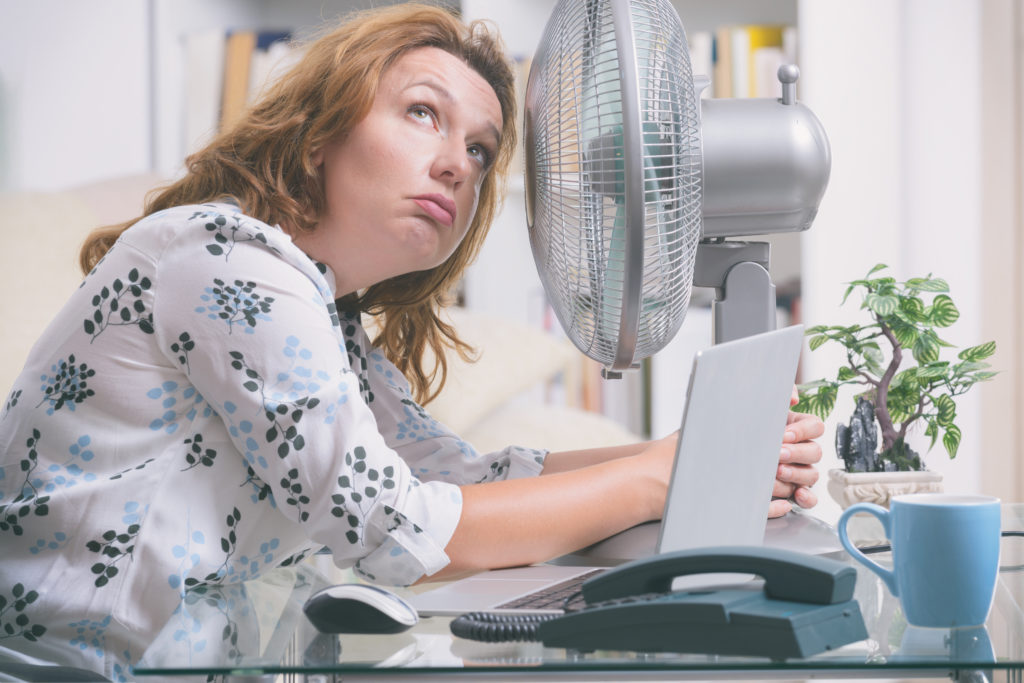Is it hot in here, or is it just you? Anyone who has experienced hot flashes knows how debilitating and disruptive they can be. And with the summer months upon us, heat and humidity can trigger them and make them even worse. Below, we’ll explore how and why hot flashes become more intense in the summer, how to tell if you’re having a hot flash, and tips for preventing future hot flashes.
Why hot flashes are worse in the summer
Hot flashes are caused in part by the changing hormone levels in your body before, during, and after menopause. During the reproductive years, women can more easily adjust to temperature changes without stimulating the hypothalamus. However, when estrogen levels begin to drop, the central thermoregulatory center—the body’s natural thermostat—experiences increased sensitivity. VMS (vasomotor symptoms of menopause) or hot flashes are triggered by small elevations in temperature in a reduced thermoneutral zone. They are the body’s attempt to cool down in response to that temperature change, often causing intense sweating and a feeling of internal heat.
Summer weather may trigger VMS because it’s not only hotter outside, but we may also experience more extreme temperature changes—for instance, going from a cold, air-conditioned office to a sweltering subway train. It’s no wonder why our bodies are on overdrive!
How to tell if you’re having a hot flash
Summertime can often feel like one giant hot flash, but there are a few key ways to tell if you’re having a hot flash versus feeling the effects of summer heat. First, VMS happens during perimenopause, menopause, and post-menopause—and 75% of women experience them. Hot flashes are more frequent in the two years after menopause, but some women will experience them during perimenopause in their 30s or 40s, and it’s possible to continue having hot flashes into your late 50s. So if you’re close to menopausal age, you might be experiencing VMS.
Next, a hot flash feels like a sudden burst of warmth in the head, face, and/neck. Your skin may become flushed, and you may experience a rapid heartbeat, sweating, and feelings of anxiety. Your skin temperature in the face, arms, chest, abdomen, back, and digits becomes elevated and blood flow to these areas increases as well. Once the body temperature drops slightly, you may also experience chills.
Although the frequency and intensity of VMS varies, they typically last from one to five minutes, but some women report hot flashes lasting up to an hour. They can happen at any time, day or night. Night sweats are also possible and can disrupt your sleep. VMS can severely disrupt daily activities, and night sweats can lead to long-term sleep issues.
Finally, hot flashes can happen at any time of the year. Summer’s heat may trigger more hot flashes, but for many women, they are a year-round event. On average, women can experience hot flashes for 10-15 years. Of course, there’s no reason for VMS to rule your life. Learn more about battling hot flashes here, and be sure to see your doctor if your hot flashes are disrupting your daily life.
What to do if you have a hot flash
First, remember that hot flashes—as awful as they can be—are a completely normal part of aging that most women experience in their lifetime. That being said, there are a few steps you can take to make a hot flash less terrible. Self-calming techniques like relaxation breathing can help: breathe deeply, slowly inhaling through your nose and exhaling through your mouth, with one hand on your stomach at the bottom of your rib cage. Do this in a comfortable position for several minutes when you feel a hot flash coming on.
Another way to help is by cooling your body down quickly. Shedding layers of clothing, drinking cold water, and/or holding a cold washcloth to your head are a few ways to manage hot flashes.
Preventing hot flashes
How can you prevent future hot flashes? Here are a few tips.
- Coffee, red wine, and spicy foods are a few common triggers—you should avoid them if you’re prone to hot flashes.
- Be sure to dress in light layers with natural fibers (as opposed to synthetic materials), especially in the summertime, and carry a personal fan to help you cool down.
- Carry a water bottle with cold water and ice whenever possible, and be sure to stay hydrated.
- If you’re experiencing hot flashes, review your medications with your doctor to make sure they are not the culprits.
- Acupuncture can be highly effective —50% of women saw reduced hot flashes with eight weeks of acupuncture treatment.
- Other mind-body treatments like yoga and hypnosis may improve the body’s response to the stress of hot flashes (although they do not impact the frequency)
- Prescription medications are available to help with hot flashes. Hormone therapy is one of the most effective, and there are numerous options.
- Non hormonal options are available too. These include SSRIs, fluoxetine, paroxetine, or sertraline, all of which are reported to reduce hot flashes from 20% to 50%.
- Incorporate more plant estrogens in your diet: soybeans, chickpeas, lentils, and flaxseed
Finally, risk factors like smoking and obesity can lead to hot flashes. As always, be sure to talk to your doctor if you think you’re at risk.
VMS shouldn’t rule your life—or your summer, for that matter. And while the vast majority of women experience them, there’s no reason to suffer through them. Shop Mia Vita Hot Flash Relief supplement. On sale now!
